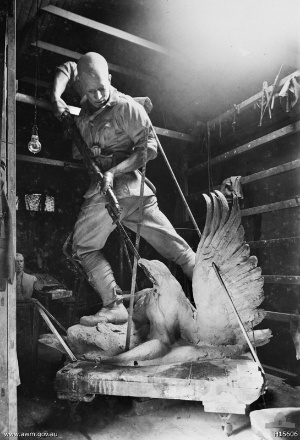Charles Web Gilbert facts for kids
C. Web Gilbert (born Charles Marsh Webb Gilbert, 18 March 1867 – 3 October 1925) was a very talented Australian sculptor. He taught himself how to create amazing artworks. Gilbert became famous for his sculptures both in Australia and around the world.
Contents
Early Life and Becoming a Sculptor
C. Web Gilbert was born in a place called Cockatoo, Victoria. His father passed away when Gilbert was just two months old. This meant his mother had to raise three young children by herself.
Gilbert went to a state school, but he started working to earn money before he was 10 years old. Later, he moved to Melbourne. He got a job at a place called Parer's Crystal Café & Hotel. There, he eventually became a pastry chef. It's believed that making decorations for wedding cakes first made him think about sculpture.
In 1888, he joined the national gallery drawing school. He studied there for about two and a half years. In the late 1890s, he started showing his sculptures at art societies like the Yarra Sculptors' Society.
Working with Materials
At first, Gilbert mostly worked with marble. This is a beautiful stone often used for sculptures. Around 1905, he started trying to cast sculptures in bronze. This was very difficult because he couldn't find anyone in Melbourne to teach him. But Gilbert didn't give up! He kept trying and became an excellent bronze caster.
He made many bronze portraits of famous people. These included artists like John Mather and John Shirlow, and writers like Hugh McCrae and Bernard O'Dowd. One of his bronze portraits was bought by the National Gallery of Victoria in 1913.
Success in London and War Art
In May 1914, Gilbert moved to London, England. He was encouraged by an American friend named Hugo Meyer. Even though World War I had started, Gilbert kept working. He was old enough to not have to join the army.
He showed his art at the Royal Academy, which is a very important art institution. People there really liked his honest and sincere work. In 1917, a marble sculpture he made called "The Critic" was bought by the Tate Gallery. This was a big achievement! He was even considered for a special membership at the Royal Academy.
Later, the Australian government hired him as a war artist. He made many models of the battlefields where Australian soldiers fought. These models were for the war museum.
Memorials and Later Works
Gilbert returned to Australia in 1920. He then finished a very important sculpture for the 2nd Division memorial. This large memorial was later revealed in France, at a place called Mont St. Quentin. A famous general, Marshal Foch, was there for the event.
Gilbert created many other important war memorials. These include large bronze sculptures of Australian soldiers. You can see them in public places in Broken Hill (New South Wales) and the City of Burnside (South Australia). He also made memorials for the Melbourne University medical school and the Victorian Chamber of Manufacturers.
He also made the small figures for a special display called a diorama. This diorama shows the "Mont St Quentin" battle and is kept at the Australian War Memorial.
Another big project was a group of three figures for the Matthew Flinders memorial. This memorial stands outside St Paul's Cathedral, Melbourne. His next major work was the Australian Memorial for Port Said in Egypt.
His Final Years
C. Web Gilbert was used to doing everything himself for his sculptures. He worked very hard, even carrying heavy clay for his huge models. Sadly, he became very tired from all this hard work and passed away suddenly on 3 October 1925.
He was married twice. He married Alice Rose Eugenia Daniell in 1887, and they later divorced. While in London, he married Mabel Annette Woodstock. He left behind his wife Mabel and three children: a daughter named Marj, and twin sons named Charlie and Jim.
Gilbert is buried at Coburg Cemetery in Preston, Victoria. You can find his grave on a special heritage walk at the cemetery. There's even a sign at his graveside with information about his life.
See also
- Australian official war artists


